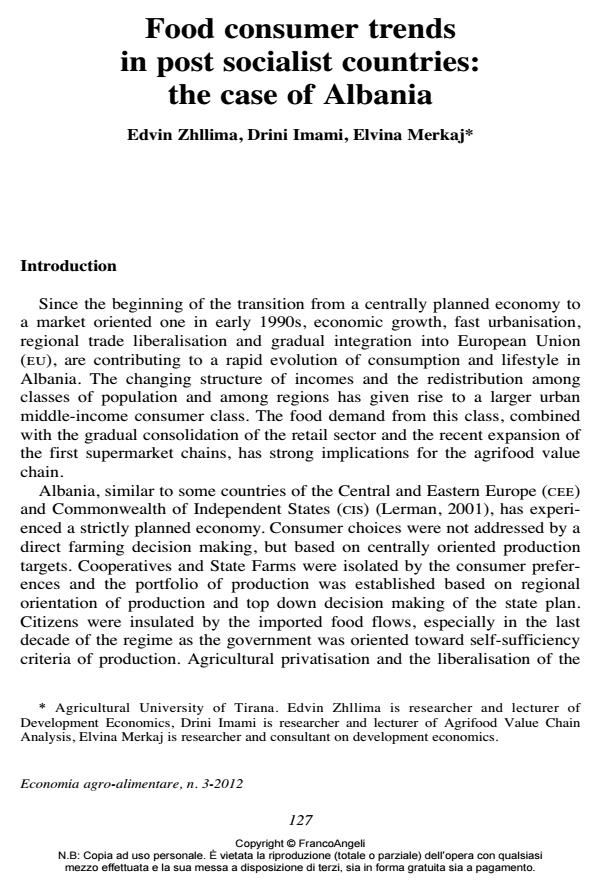Food consumer trends in post socialist countries: the case of Albania
Titolo Rivista ECONOMIA AGRO-ALIMENTARE
Autori/Curatori Edvin Zhllima, Drini Imami, Elvina Merkaj
Anno di pubblicazione 2012 Fascicolo 2012/3
Lingua Italiano Numero pagine 11 P. 127-137 Dimensione file 705 KB
DOI 10.3280/ECAG2012-003007
Il DOI è il codice a barre della proprietà intellettuale: per saperne di più
clicca qui
Qui sotto puoi vedere in anteprima la prima pagina di questo articolo.
Se questo articolo ti interessa, lo puoi acquistare (e scaricare in formato pdf) seguendo le facili indicazioni per acquistare il download credit. Acquista Download Credits per scaricare questo Articolo in formato PDF

FrancoAngeli è membro della Publishers International Linking Association, Inc (PILA)associazione indipendente e non profit per facilitare (attraverso i servizi tecnologici implementati da CrossRef.org) l’accesso degli studiosi ai contenuti digitali nelle pubblicazioni professionali e scientifiche
Since the beginning of the transition from a centrally planned economy to a market oriented economy in early 1990’s, economic growth, fast urbanisation, regional trade liberalisation, and gradual integration into eu, are contributing to a rapid evolution of consumption and lifestyle in Albania. The changing structure of the incomes emerging from an increasing per capita gdp and the redistribution among classes of population and among regions (urban population benefiting more from the growth than rural) has given rise to a larger urban middle-income class of consumers. The food demand from the emerging urban middle-income consumers, combined with the gradual consolidation of the retail sector and the recent establishment and expansion of the first supermarket chains, has strong implications for the agrifood industry. Despite these rapid changes, there are few attempts from researchers and other stakeholders to study the consumer preferences in the country. Understanding consumer preferences is important not only for agrifood entrepreneurs but also for government policy makers to tune their policies and allocate their resources more efficiently in line with market demand. The objective of this paper is to describe the main consumption trends and key issues in Albania, analysis of the Albanian consumer patterns and dynamics of the last decades for the main food categories, along with comparisons to the rest of the world. The study finds that the demand toward meat, fruits and vegetables has experienced a significant increase compared to more staple foods such as cereal. The consumer preferences indicate similar features with other transition countries. There is observed an overall preference for domestic agrifood products. However, there are concerns about the perceived quality and safety of various agrifood products in Albania. There is obvious distrust in the government food safety enforcement system, while privately enforced quality and safety systems are almost missing. Strengthening the implementation capacities and improving the image of the government food safety regulation system should be considered a priority in the context of ongoing institutional and legal reforms, such that the preference for domestic produce and products increase to match consumer preferences.;
Keywords:Consumer preferences, agrifood products, food safety, Albania
Jel codes:D1
- Consumer perceptions of food safety risk: Evidence from a segmentation study in Albania Edvin Zhllima, Drini Imami, Maurizio Canavari, in Journal of Integrative Agriculture /2015 pp.1142
DOI: 10.1016/S2095-3119(14)60997-7
Edvin Zhllima, Drini Imami, Elvina Merkaj, Food consumer trends in post socialist countries: the case of Albania in "ECONOMIA AGRO-ALIMENTARE" 3/2012, pp 127-137, DOI: 10.3280/ECAG2012-003007